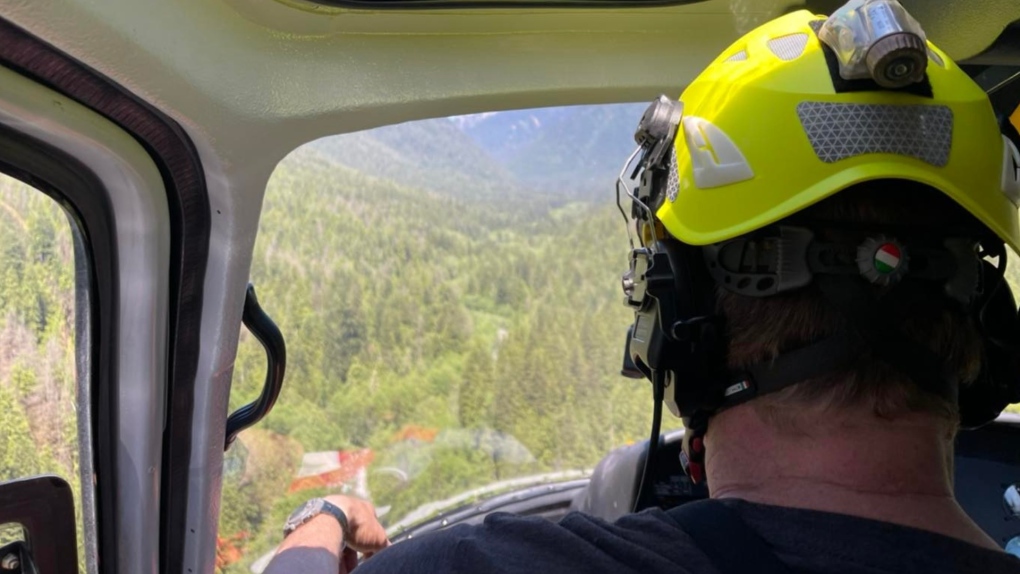Injured North Shore hiker rescued by helicopter on busy weekend for SAR crews
 As B.C.'s Lower Mainland experiences its first heat wave of the summer, North Shore Search and Rescue crews are being kept busy.
As B.C.'s Lower Mainland experiences its first heat wave of the summer, North Shore Search and Rescue crews are being kept busy.
A satellite device likely saved the life of an injured hiker on the North Shore Sunday, according to search and rescue crews who say the warm weather has made for a busy weekend.
North Shore Rescue's Jim Lore says this particular hiker broke his arm and suffered other injuries when he fell down in Wickenden Creek.
The beacon he had allowed him to alert the RCMP who called in the SAR team. A helicopter was dispatched and the hiker was successfully hoisted to safety before an ambulance took him away.
"Fortunately, he had that device," he said. 'It would have been a much different outcome if he didn’t."
In addition to having a reliable way to communicate, Lore says it's important to wear brightly coloured clothing, adding this rescue was complicated because the hiker was effectively camouflaged.
"We had to fly over a few times before we are able to locate him," he toldCTV News.
As the region experiences the year's first blast of hot weather, parking lots at popular hiking destinations like Lynn Valley and Mont Fromme quickly filled up as people ventured onto trails and into the backcountry.
"I think everybody's been anxious to get out into the outdoors with the colder spring we've had. This is our first really nice weather so it's super busy up there, lots of people around," he said adding crews were also called out three times on Saturday.
Lore's key top for staying safe is to be prepared -- which this hiker was.
"Always plan for things to go wrong and you'll be in a lot better position of they do go wrong," he said.
Preparation includes getting familiar with the terrain and the level of experience needed to safely navigate it by doing research ahead of time. It also means telling someone what the plan is.
"Tell people where you're going, that way if you don't show up at least we know where to start looking," Lore said.
Having the right gear is also key.
On the lower parts of the trails, high temperatures mean it's crucial to stay hydrated. At higher elevations, Lore says, it's important to remember there is still snow. Having warm clothes, crampons, and an ice axe are some key ways to be ready for those conditions.
Even with longer days, Lore said a flashlight is a must-have.
More tips on how to prepare for the outdoors are available from Adventure Smart.
CTVNews.ca Top Stories

'Thankful for the rest of my life': Woman's final goodbye with father captured on video at Winnipeg airport
One woman is expressing her deepest gratitude to the Winnipeg Richardson International Airport after the staff helped her retrieve the security footage of her final moments with her father.
A father who stayed by his son's bedside were among the victims in California's wildfires
An amputee and his son with cerebral palsy were among the 11 deaths in the fires raging around Los Angeles. The father was found at his son’s bedside.
Lone sailor trapped in ice sparks concern in Southern Georgian Bay
A lone sailor living on a sailboat trapped in the Georgian Bay ice has sparked concern among Penetanguishene residents.
Former B.C. premier says she 'misspoke' when claiming she was never a Conservative
Former British Columbia premier Christy Clark, who is considering a run for federal Liberal leader, has backtracked on her claim this week that she'd never been a member of the Conservative party.
U.S. special counsel Jack Smith has resigned
U.S. Special counsel Jack Smith has resigned from the Justice Department effective Friday, according to a court filing.
UPDATED Anita Anand will not seek Liberal leadership
Transport Minister Anita Anand announced on social media Saturday she will not seek the leadership of the Liberal Party, nor will she run for re-election in the riding of Oakville.
This Canadian teen lost her hands and feet, she says more people should know how it happened
A Canadian teen is reaching audiences around the world with powerful social media videos showing life without hands and feet – the price she paid after developing sepsis.
'It's not realistic': Former PM Chretien thinks Trump will back off trade war
Former prime minister Jean Chretien says U.S. president-elect Donald Trump is likely to walk back his threat of punishing tariffs and the resulting trade war with Canada, because the Americans are too reliant on a number of Canadian exports, namely in the energy sector.
Heroes in action: Strangers lift car to rescue a woman pinned underneath
A group of good Samaritans teamed up with law enforcement this week to save an elderly woman pinned underneath her car in Lawerence, Mass.































